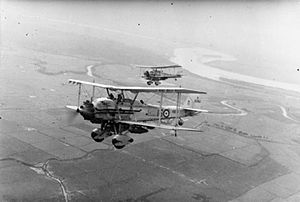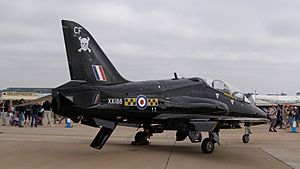No. 100 Squadron RAF facts for kids
Quick facts for kids No. 100 Squadron RAF |
|
|---|---|

Squadron badge
|
|
| Active |
|
| Country | |
| Branch | |
| Type | Flying squadron |
| Motto(s) | Sarang tebuan jangan dijolok (Malay for 'Never stir up a hornet's nest') |
| Disbanded | 31 March 2022 |
| Insignia | |
| Squadron badge heraldry | In front of two bones in saltire, a skull. The badge was the official version of a motif used by the squadron on the Western Front in 1917. Approved by King George VI in November 1937. |
| Squadron roundel |  |
| Squadron codes | RA (Apr 1939 – Sep 1939) HW (Dec 1942 – Apr 1951) AS/GB (1946) CA–CZ (Hawks) |
Number 100 Squadron was a special flying unit of the Royal Air Force, also known as the RAF. It was known for flying 'aggressor' aircraft, which means they acted as enemy planes during training exercises. This helped other pilots practice air combat. The squadron last used the British Aerospace Hawk T1 jet from RAF Leeming in North Yorkshire, UK. It was officially closed down on March 31, 2022.
Contents
History of 100 Squadron
First World War Missions
No. 100 Squadron was created on February 23, 1917, in Hingham, Norfolk. It was the very first squadron of the Royal Flying Corps (the RAF's earlier name) made specifically for bombing at night.
The squadron moved to France on March 21, 1917. They were based at St Andre-aux-Bois and received twelve Royal Aircraft Factory F.E.2B aircraft. These planes were changed to work better for night missions.
On April 1, 1917, the squadron moved to Izel-le-Hameau and got four more planes, B.E.2es. Their first mission was on the night of April 5/6, 1917. Eleven FE2b aircraft attacked La Brayelle Airfield in Douai, where the famous German pilot Manfred von Richthofen's 'Flying Circus' was located. Richthofen even wrote about this attack in his book. They dropped many bombs, and four aircraft hangars were reported to be on fire. One of their planes was lost.
On March 4, 1918, the squadron moved to Ochey, near Nancy. Here, they became a key part of the Independent Air Force under Major General Hugh Trenchard. In August 1918, they started using Handley Page 0/400 heavy bombers. These planes could fly much longer distances, allowing them to bomb industrial sites deep inside Germany. The squadron continued these raids until the war ended. One of their planes was the very last to return from a raid on the night before the Armistice (the end of the war).
Between the World Wars
After the First World War, the squadron stayed in Europe until September 1919. Then, it moved to RAF Baldonnel near Dublin. There, it was fully re-formed and received Bristol F.2 Fighters. These planes were used to help the army during the Irish War of Independence.
After the fighting ended, the squadron moved to Spitalgate, Lincolnshire, in February 1922. They changed their role to bombing again, using Vickers Vimys and DH9As.
In May 1924, the squadron got new Fairey Fawn aircraft. With these planes, they even helped carry air-mail during the General Strike of 1926. In September of that year, they started using Hawker Horsley aircraft. In November 1930, they moved to Donibristle, Fife, and began training for torpedo-bombing. In 1933, their official name became 'No. 100 (Torpedo-Bomber) Squadron'.
In November 1932, they received the Vickers Vildebeest aircraft. With these planes, the squadron was sent to help defend Singapore, arriving at Seletar in January 1934.
Second World War Actions

When the Second World War began, the squadron was ready. However, they saw little action while based in Seletar until December 1941. In November and December 1941, some parts of the squadron were sent to Fisherman's Bend in Australia.
The squadron was supposed to get new Bristol Beaufort planes, but they didn't arrive. So, they had to use their older Vildebeest aircraft to fight against the advancing Japanese forces. Because of this, in January 1942, the squadron lost most of its planes in battles with Japanese fighters. Even though they tried to keep fighting as one unit with No. 36 Squadron RAF, most of their members eventually became prisoners of war as Japan advanced in the Far East.
On December 15, 1942, No. 100 Squadron RAF was re-formed in the UK at RAF Grimsby, near Waltham. They became a night-time heavy bomber squadron and were part of No. 1 Group RAF, RAF Bomber Command. In January 1943, the squadron received its new Avro Lancaster planes. Their first mission was on March 4, 1943, attacking a U-boat base at St Nazaire.
A few days later, the squadron took part in a raid against Nuremberg in Germany. From then on, as part of Bomber Command's main strategy against Germany, they participated in every major bombing raid.
By the end of 1943, the squadron had completed the second-highest number of successful missions in their group and had the lowest number of planes lost. On the night of December 16/17, 1943, the squadron was ordered to attack Berlin. This raid became known as 'Black Thursday' because Bomber Command lost 25 aircraft during the mission and 28 more crashed at airfields covered in fog. That night, 100 Squadron lost their commanding officer, David Holford, who crash-landed while trying to land at RAF Grimsby.
On the night of June 5, 1944, the squadron bombed heavy gun batteries to support the D-Day invasion.
For the last month of the war, the squadron moved to Elsham Wolds in Lincolnshire. After the war, the squadron helped with humanitarian missions called Operations Manna and Exodus. These missions delivered food and brought prisoners of war home. In December 1945, the squadron moved to RAF Scampton, being the last squadron there to fly the Avro Lancaster. The squadron then moved to RAF Lindholme in May 1946.
Cold War Operations
Between 1946 and 1950, the squadron was based at RAF Hemswell. They flew Avro Lancasters and later Avro Lincolns. In 1950, the squadron left Hemswell and moved to Malaysia. There, they were involved in Operations Firedog and Musgrave.
In January 1954, the squadron went to Eastleigh in Kenya during the Mau Mau Uprising. They returned two months later and were re-equipped with English Electric Canberras. They then moved to Wittering in Cambridgeshire. The squadron was closed down on September 1, 1959.
However, it was re-formed at Wittering on May 1, 1962. This time, they were equipped with Handley Page Victor B.2s. From early 1964, these planes carried the Blue Steel missile nuclear weapon.
Target Training Role

The squadron was disbanded again on September 30, 1968. But it was re-formed in 1972 as a 'target facilities unit'. This meant they used Canberra aircraft to act as targets for other planes to practice against. They were based at RAF West Raynham in Norfolk.
No. 100 Squadron then joined with 85 and 98 Squadrons. They operated 26 Canberra aircraft from RAF Marham before moving to RAF Wyton in Cambridgeshire in 1982. In 1991, the squadron switched to the Hawker Siddeley Hawk T1. These planes were used for training and supporting front-line operations. On August 31, 1994, the squadron moved to RAF Finningley in South Yorkshire. When it was announced that RAF Finningley would close, 100 Squadron moved to RAF Leeming.
Flying Training and Disbandment
In January 2019, it was announced that No. 100 Squadron would take on an extra role: fast jet flying training. This was because the RAF needed more training capacity for their Hawk T2 aircraft. This new role came three years after fast jet training with the Hawk T1 officially ended in 2016.
The Hawk T1's role was supposed to be replaced by a program called Air Support to Defence Operational Training (ASDOT). This program aimed to provide 'aggressor' training for all three British armed forces. However, the ASDOT program was cancelled in March 2019.
The squadron was expected to stop using its Hawk T1 aircraft in 2027. But in July 2021, it was announced that, except for the Red Arrows display team, all other Hawk T1 aircraft in the British military would be retired by March 31, 2022. As a result, No. 100 Squadron was officially disbanded on March 31, 2022.
Notable People
- Wing Commander R V McIntyre: He was the Commanding Officer of the squadron from April to November 1943. He earned the DFC award. This was after he successfully dropped bombs over Bochum on May 13, 1943. His plane had lost two engines from anti-aircraft fire over Cologne, but he still managed to make a successful crash landing at RAF Coltishall, Norfolk.
- Peter J. M. Squires: He was the Officer Commanding from April 2009 to April 2011.
- Rory Underwood: A famous former England Rugby Union player.
Squadron Flag
The squadron had a special flag. It was later decorated with the squadron's name and the motto Blood and Bones. The original flag was dark maroon. It was looked after by a Flight Lieutenant Trillwood, but it fell apart while he was a Japanese prisoner of war. After the war, the flag was replaced with a black one. In 2008, for the squadron's 90th anniversary, a copy of the original maroon flag was given to the squadron by Arthur White, who was a navigator with them during the Second World War.
Aircraft Used
Here are some of the aircraft that No. 100 Squadron operated:
- Royal Aircraft Factory B.E.2c (1917–1918)
- Royal Aircraft Factory F.E.2b (1917–1918)
- Royal Aircraft Factory B.E.2e (1917)
- Royal Aircraft Factory F.E.2c (1918)
- Handley Page 0/400 (1918–1919)
- Bristol F.2b Fighter (1920–1922)
- Airco DH.9A (1920–1921)
- Avro 504K (1922–1924)
- Vickers Vimy (1922–1923)
- Fairey Fawn Mk.II/Mk.III (1924–1926)
- Hawker Horsley Mk.I/Mk.II (1926–1933)
- Vickers Vildebeest Mk.I (1932–1933)
- Vickers Vildebeest Mk.II (1933–1941)
- Vickers Vildebeest Mk.III (1937–1942)
- Bristol Beaufort Mk.I (1941–1942)
- Avro Lancaster Mk.I/Mk.III (1942–1946)
- Avro Lincoln B.2 (1946–1954)
- English Electric Canberra B.2 (1954–1959; 1972–1991)
- English Electric Canberra B.6 (1956–1959)
- English Electric Canberra PR.7 (1956–1957; 1982–1991)
- English Electric Canberra B(I).8 (1956–1959)
- Handley Page Victor B.2 (1962–1964)
- Handley Page Victor B.2R (1963–1968)
- English Electric Canberra T.19 (1972–1980)
- English Electric Canberra E.15 (1976–1991)
- English Electric Canberra TT.18 (1982–1991)
- British Aerospace Hawk T.1/T.1A (1991–2022)
Battle Honours
No. 100 Squadron earned several special recognitions called battle honours. These are given for important actions or battles. The ones marked with an asterisk (*) could be displayed on the squadron's official flag.
|
See also
- List of Royal Air Force aircraft squadrons


